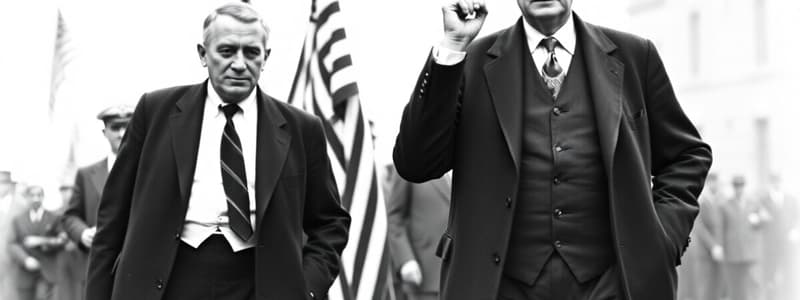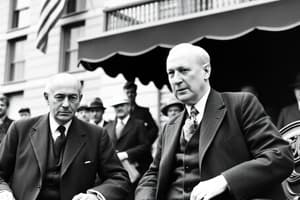Podcast
Questions and Answers
What was one major cause of the Great Depression?
What was one major cause of the Great Depression?
- Increased agricultural prices
- High consumer spending
- Strong foreign demand for American goods
- Poor diversification in the US economy (correct)
Hoover believed that the US economy would recover quickly from the Great Depression.
Hoover believed that the US economy would recover quickly from the Great Depression.
False (B)
What food-related issue became significant during Hoover's response to the Great Depression?
What food-related issue became significant during Hoover's response to the Great Depression?
Food scarcity
Shelters constructed during the Great Depression were commonly referred to as __________.
Shelters constructed during the Great Depression were commonly referred to as __________.
Match the following terms with their descriptions:
Match the following terms with their descriptions:
Which of the following events occurred during the 1920 election?
Which of the following events occurred during the 1920 election?
Warren G. Harding was known for his strong legislative achievements in the Senate.
Warren G. Harding was known for his strong legislative achievements in the Senate.
What was the name of the pact signed by 100 nations that aimed to outlaw wars like World War I?
What was the name of the pact signed by 100 nations that aimed to outlaw wars like World War I?
Calvin Coolidge was nicknamed the __________.
Calvin Coolidge was nicknamed the __________.
The Teapot Dome Affair involved which of the following?
The Teapot Dome Affair involved which of the following?
Match the following figures with their roles during the Harding administration:
Match the following figures with their roles during the Harding administration:
The 4 Power treaty called for the reduction of naval forces among the United States, Great Britain, Japan, and Italy.
The 4 Power treaty called for the reduction of naval forces among the United States, Great Britain, Japan, and Italy.
What was one of Calvin Coolidge's main economic policies?
What was one of Calvin Coolidge's main economic policies?
What was one reason income tax was raised during World War I?
What was one reason income tax was raised during World War I?
Herbert Hoover won the election of 1928 after Coolidge decided to run again.
Herbert Hoover won the election of 1928 after Coolidge decided to run again.
What type of market is characterized by rising stock prices?
What type of market is characterized by rising stock prices?
Henry Ford paid his workers _____ dollars a day, enabling them to afford cars.
Henry Ford paid his workers _____ dollars a day, enabling them to afford cars.
Match the following events with their significance:
Match the following events with their significance:
Which product was notably linked to the rise of consumerism in the 1920s?
Which product was notably linked to the rise of consumerism in the 1920s?
The Dow Jones Average was 88 in 1928 and tripled in one year.
The Dow Jones Average was 88 in 1928 and tripled in one year.
What was a major consequence of the stock market crash in 1929?
What was a major consequence of the stock market crash in 1929?
Flashcards
1920 Election
1920 Election
Presidential election in 1920 with Republican Warren G. Harding defeating Democrat James Cox.
Harding Administration
Harding Administration
Warren G. Harding's presidency marked by scandals and political corruption, including the "Ohio Gang" and Teapot Dome scandal.
Teapot Dome Scandal
Teapot Dome Scandal
A bribery incident during the Harding administration involving the secret leasing of oil reserves.
Coolidge Economy
Coolidge Economy
Signup and view all the flashcards
Kellogg-Briand Pact
Kellogg-Briand Pact
Signup and view all the flashcards
Washington Naval Conference
Washington Naval Conference
Signup and view all the flashcards
Silent Cal
Silent Cal
Signup and view all the flashcards
Return to Normalcy
Return to Normalcy
Signup and view all the flashcards
Stock Market Indicator
Stock Market Indicator
Signup and view all the flashcards
Great Depression Cause (Diversification)
Great Depression Cause (Diversification)
Signup and view all the flashcards
Over-reliance on Durable Goods
Over-reliance on Durable Goods
Signup and view all the flashcards
Reduced Foreign Demand
Reduced Foreign Demand
Signup and view all the flashcards
Hoover's Approach to the Depression
Hoover's Approach to the Depression
Signup and view all the flashcards
Roaring 20s Consumerism
Roaring 20s Consumerism
Signup and view all the flashcards
Henry Ford's Wage Model
Henry Ford's Wage Model
Signup and view all the flashcards
1928 Election
1928 Election
Signup and view all the flashcards
New York Stock Exchange
New York Stock Exchange
Signup and view all the flashcards
Dow Jones Industrial Average
Dow Jones Industrial Average
Signup and view all the flashcards
Bull Market
Bull Market
Signup and view all the flashcards
Margin Buying
Margin Buying
Signup and view all the flashcards
Stock Market Crash of 1929
Stock Market Crash of 1929
Signup and view all the flashcards
Study Notes
The 1920s: Politics and Economics
- Spectator sports (baseball, basketball, football) gained popularity.
- Consumerism increased.
- Women's roles changed.
- The 1920 election saw a Democratic candidate (James Cox) advocating for the US joining the League of Nations, while the Republican candidate (Warren G. Harding) promised a "return to normalcy."
- Harding's administration was plagued by scandals, including the Ohio Gang and Charles Forbes's improper money collection. Albert Fall was involved in the Teapot Dome Affair.
- The Washington Naval Conference aimed to reduce naval size and respect possessions in the Pacific.
- The 4-Power treaty and 5-Power treaty were agreements on naval disarmament.
- The 9-Power treaty focused on respecting the open door policy in China.
- Calvin Coolidge, Harding's successor, prioritized economic fixes and cut taxes, aiming to put money into consumers' hands.
Coolidge Economy Efforts
- Coolidge sought to continue Harding's reforms, focusing on the transition from wartime to peacetime production to stimulate the economy.
- He reduced government spending and cut taxes to boost consumer spending.
- Government regulations were relaxed to allow business to thrive.
Consumerism Boost
- Cars became popular, especially the Model T, which Henry Ford made affordable for workers with wages and credit.
- Other consumer goods like radios, refrigerators, and washing machines were in high demand.
- Urban living surpassed rural living for the first time in the US.
Election of 1928
- Herbert Hoover ran for president, inheriting an already burgeoning economy.
New York Stock Exchange (1928)
- The Dow Jones Industrial Average reached a significant high in 1928.
- The stock market experienced heavy buying with speculation and margin buying (buying stocks with borrowed money).
Stock Market Crash
- The stock market experienced a major decline in 1929.
- The crash led to the Great Depression.
Causes of the Great Depression
- Poor diversification of the US economy, primarily relying on industrial output. Farm prices fell, which harmed agricultural economies.
- Over-reliance on durable goods; items that last long didn't consistently require replacement.
- Weak foreign demand, as other countries began producing their own goods and no longer relied on US products.
Hoover's Response
- Hoover's administrations failed to grasp the severity of the depression.
- Economic hardship led to widespread hardship, including unemployment and hunger.
Studying That Suits You
Use AI to generate personalized quizzes and flashcards to suit your learning preferences.




